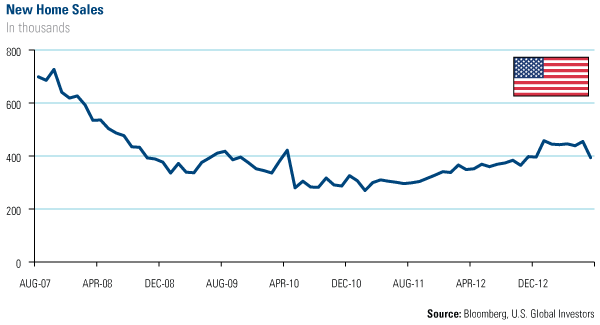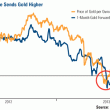The Economy and Bond Market Radar (August 26, 2013)
Treasury yields were mixed this week as the long end of the yield curve fell by a few basis points while the short-to-intermediate portion of the curve rose by a few basis points. The conventional wisdom has it that the Fed will begin “tapering” at the September 17-18 FOMC meeting as the minutes from the July 30-31 FOMC meeting did not clearly signal a different direction for policy. Fed policymakers have indicated a desire to begin winding down their quantitative easing program but recent economic data points are not making it easy. The economy has been sluggish, growing less than 2 percent in the first half of the year, and the recent increase in bond yields is already having an impact on activity as can be seen in the new home sales chart below. New home sales fell 13.4 percent in July, which was the biggest drop since May 2010 and complicates the Fed’s exit strategy.
Strengths
- Global manufacturing indicators are starting to pick up, with China’s HSBC/Markit Flash Purchasing Managers’ Index (PMI) rising more than expected and into expansion territory.
- The eurozone composite PMI hit the highest level in 2 years and is also indicating expansion.
- The Conference Board’s index of leading indicators rose 0.6 percent in July, which bodes well for economic activity in the next six months.
Weaknesses
- New home sales fell 13.4 percent in July, which was the biggest drop since May 2010.
- Rising inflation and depreciating currencies are causing global central banks to raise interest rates.
- The treasury market rallied on Friday but during the week the 10-year Treasury yield rose to new 52-week highs, nearing 2.90 percent.
Opportunity
- Despite recent conflicting commentary, the Fed continues to remain committed to an overall accommodative policy.
- Key global central bankers are still in easing mode such as the European Central Bank, the Bank of England and the Bank of Japan.
- The recent selloff in bonds is likely an opportunity as higher yields will act as a brake on the economy and potentially become self-fulfilling, thus postponing Fed action.
Threat
- Inflation in some corners of the globe is getting the attention of policymakers and may be an early indicator for the rest of the world.
- Trade and/or currency “wars” cannot be ruled out which may cause unintended consequences and volatility in the financial markets.
- The recent bond market sell off may be a “shot across the bow” as the markets reassess the changing macro dynamics.















